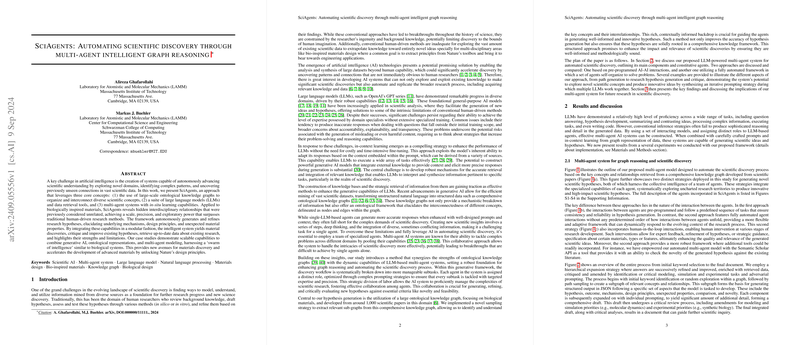Analyzing SciAgents: Automating Scientific Discovery through Multi-Agent Intelligent Graph Reasoning
"SciAgents: Automating Scientific Discovery through Multi-Agent Intelligent Graph Reasoning" presents a novel framework designed to enhance the process of scientific discovery by employing a combination of ontological knowledge graphs, LLMs, and multi-agent systems. The framework, named SciAgents, is showcased primarily in the context of bio-inspired materials, highlighting its ability to unearth interdisciplinary relationships at a scale and depth that surpass traditional methods.
Core Concepts and Methodology
SciAgents leverages three principal components:
- Ontological Knowledge Graphs: These graphs structure and interconnect diverse scientific concepts using a comprehensive, hierarchical organization of knowledge extracted from a large corpus of scientific literature.
- LLMs: These models, exemplified by the GPT-4 family, underpin the system's ability to generate human-like text, offering sophisticated reasoning and information retrieval capabilities.
- Multi-Agent Systems: A suite of specialized agents with in-situ learning capabilities collaborates to autonomously generate, critique, and refine research hypotheses.
The methodology initiates with the construction of a knowledge graph that maps relationships between various scientific concepts. This graph becomes the substrate for detailed analysis, followed by the generation of research hypotheses. The multi-agent system comprises different roles, including Ontologist, Scientists, and Critic agents, which interact dynamically to enhance the hypothesis generation process.
Results and Discussion
The researchers demonstrated the system's efficacy through a series of experiments, using bio-inspired materials as a case paper. For instance, by connecting the concepts of "silk" and "energy-intensive", SciAgents generated a research hypothesis involving the integration of silk with dandelion-based pigments to create biomaterials with enhanced optical and mechanical properties. The proposed outcomes included significant improvements in mechanical strength and energy efficiency, which were quantitatively substantiated by the model's predictions.
The paper highlighted two approaches for multi-agent collaboration:
- Pre-Programmed Interactions: Agents follow a predefined sequence of tasks to ensure consistency.
- Fully Automated Interactions: A more flexible framework where agents self-organize, enabling dynamic responses to the evolving research context. This approach also incorporates the Semantic Scholar API to verify the novelty of the generated hypotheses.
Both models exhibited the ability to produce innovative research ideas, though the automated approach provided greater adaptability and integration of external tools for comprehensive analysis.
Implications and Future Directions
SciAgents represents a significant advancement in automating scientific discovery. By integrating ontological knowledge representation with multi-agent systems, the framework substantially enhances the scalability and depth of research hypothesis generation. The system's ability to identify and exploit previously unnoticed relationships among concepts paves the way for breakthroughs across various scientific domains.
Practical Implications:
- Materials Science: Accelerates the discovery of new materials by predicting properties and potential applications using bio-inspired principles.
- Interdisciplinary Research: Facilitates the exploration of complex, multifaceted scientific questions that require synthesizing knowledge from diverse fields.
Theoretical Implications:
- AI Collaboration: Demonstrates the power of multi-agent systems in complex problem-solving, highlighting the potential for more sophisticated, autonomous AI systems in scientific research.
- Generative AI: Advances the application of LLMs in structured, context-aware hypothesis generation, moving beyond simple text generation to more nuanced, interdisciplinary reasoning.
Looking forward, integrating experimental and simulation functionalities within the multi-agent framework could further enhance the system's capabilities. For instance, enabling agents to conduct real-time molecular simulations or access experimental databases could yield a more iterative and robust discovery process. Continuous improvement in LLMs will also enhance the depth and accuracy of the generated hypotheses, making the AI a more integral part of scientific exploration.
In conclusion, SciAgents offers a compelling vision for the future of AI-driven scientific discovery. By combining ontological knowledge, LLMs, and a sophisticated multi-agent system, this framework can potentially transform the pace and scope of research across various domains, particularly in fields requiring interdisciplinary approaches. It underscores the evolving role of AI in not just supporting, but actively driving, the next wave of scientific innovations.
